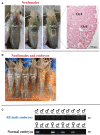Full Functional Sex Reversal Achieved Through Silencing of MroDmrt11E Gene in Macrobrachium rosenbergii: Production of All-Male Monosex Freshwater Prawn
- PMID: 35370930
- PMCID: PMC8970045
- DOI: 10.3389/fendo.2021.772498
Full Functional Sex Reversal Achieved Through Silencing of MroDmrt11E Gene in Macrobrachium rosenbergii: Production of All-Male Monosex Freshwater Prawn
Abstract
The freshwater prawn Macrobrachium rosenbergii is one kind of important economic aquaculture species and displays remarkable sexual dimorphism. The molecular mechanism of sexual differentiation in M. rosenbergii has been primarily unraveled through the research efforts of the androgenic gland and its related genes. However, the understanding of conserved genes involved in the molecular mechanism underpinning sex determination and sexual differentiation of M. rosenbergii is still fragmentary. MroDmrt11E is a member of the doublesex and mab-3-related transcription factor (Dmrt) gene family and is prominently expressed in the testis. In the present study, in vivo knockdown of MroDmrt11E at the postlarva stage in male prawn induced a complete and functional sex reversal and achieved the production of an all-male monosex population. Furthermore, a great deal of new information of upregulated and downregulated transcriptions involved in sexual differentiation of MroDmrt11E knockdown was enriched by comparative transcriptomic analysis. The effects of RNAi-mediated gene knockdown of MroDmrt11E on the differentially expressed and sex-related candidate genes, such as transformer, fruitless, feminization, insulin-like androgenic gland gene, Dmrt gene family, were primarily focused on, and their possible molecular regulatory relationships in sexual differentiation were analyzed. Meanwhile, the response of primary Kyoto Encyclopedia of Genes and Genomes (KEGG) biological pathways was investigated to expound the potential roles of MroDmrt11E in male sexual differentiation, which provided a deeper understanding of the molecular regulatory network underlying sexual differentiation of M. rosenbergii. The finding provided a novel sexual manipulation technique through silencing of Dmrt gene family for achieving a complete and functional sex reversal and offered a new insight regarding the mechanism of the Dmrt gene family in the sexual differentiation of crustaceans.
Keywords: Macrobrachium rosenbergii; MroDmrt11E gene knockdown; all-male monosex population; sex reversal; sexual differentiation.
Copyright © 2022 Xu, Chen, Wang, Luo, Li, Shen, Yang and Ma.
Conflict of interest statement
The authors declare that the research was conducted in the absence of any commercial or financial relationships that could be construed as a potential conflict of interest.
Figures




Similar articles
-
Monosex Populations of the Giant Freshwater Prawn Macrobrachium rosenbergii-From a Pre-Molecular Start to the Next Generation Era.Int J Mol Sci. 2023 Dec 13;24(24):17433. doi: 10.3390/ijms242417433. Int J Mol Sci. 2023. PMID: 38139271 Free PMC article. Review.
-
Timing sexual differentiation: full functional sex reversal achieved through silencing of a single insulin-like gene in the prawn, Macrobrachium rosenbergii.Biol Reprod. 2012 Mar 30;86(3):90. doi: 10.1095/biolreprod.111.097261. Print 2012 Mar. Biol Reprod. 2012. PMID: 22133694
-
Involvement of the ovarian-specific Mro-IR in oogonia differentiation and oocyte development in freshwater giant prawn Macrobrachium rosenbergii.Front Endocrinol (Lausanne). 2025 Apr 3;16:1516849. doi: 10.3389/fendo.2025.1516849. eCollection 2025. Front Endocrinol (Lausanne). 2025. PMID: 40248152 Free PMC article.
-
Screening for Dmrt genes from embryo to mature Macrobrachium rosenbergii prawns.Gen Comp Endocrinol. 2019 Oct 1;282:113205. doi: 10.1016/j.ygcen.2019.06.009. Epub 2019 Jun 12. Gen Comp Endocrinol. 2019. PMID: 31201800
-
Crustacean endocrinology: Sexual differentiation and potential application for aquaculture.Gen Comp Endocrinol. 2024 Sep 15;356:114578. doi: 10.1016/j.ygcen.2024.114578. Epub 2024 Jul 5. Gen Comp Endocrinol. 2024. PMID: 38971237 Review.
Cited by
-
Monosex Populations of the Giant Freshwater Prawn Macrobrachium rosenbergii-From a Pre-Molecular Start to the Next Generation Era.Int J Mol Sci. 2023 Dec 13;24(24):17433. doi: 10.3390/ijms242417433. Int J Mol Sci. 2023. PMID: 38139271 Free PMC article. Review.
-
Pathogenicity of Citrobacter freundii Causing Mass Mortalities of Macrobrachium rosenbergii and Its Induced Host Immune Response.Microorganisms. 2024 Oct 17;12(10):2079. doi: 10.3390/microorganisms12102079. Microorganisms. 2024. PMID: 39458388 Free PMC article.
-
CRISPR/Cas9-mediated gene mutation of EcIAG leads to sex reversal in the male ridgetail white prawn Exopalaemon carinicauda.Front Endocrinol (Lausanne). 2023 Nov 21;14:1266641. doi: 10.3389/fendo.2023.1266641. eCollection 2023. Front Endocrinol (Lausanne). 2023. PMID: 38075036 Free PMC article.
-
Role of Mn-LIPA in Sex Hormone Regulation and Gonadal Development in the Oriental River Prawn, Macrobrachium nipponense.Int J Mol Sci. 2024 Jan 23;25(3):1399. doi: 10.3390/ijms25031399. Int J Mol Sci. 2024. PMID: 38338678 Free PMC article.
-
Sex Reversal Induced by Dietary Supplementation with 17α-Methyltestosterone during the Critical Period of Sex Differentiation in Oriental River Prawn (Macrobrachium nipponense).Animals (Basel). 2023 Apr 17;13(8):1369. doi: 10.3390/ani13081369. Animals (Basel). 2023. PMID: 37106932 Free PMC article.
References
-
- Shen SQ, Li JW, Xu HJ, Yang JS, Ma WM, Qian GY. Sexual Characteristic Development and Sex Identification of Juvenile Prawns, Macrobrachium Rosenbergii . Aquac Res (2020) 51:3718–28. doi: 10.1111/are.14721 - DOI
-
- Aflalo ED, Dandu RVSN, Verghese JT, Rao N, Samraj TYC, Ovadia O, et al. . Neo-Females Production and All-Male Progeny of a Cross Between Two Indian Strains of Prawn (Macrobrachium Rosenbergii): Population Structure and Growth Performance Under Different Harvest Strategies. Aquaculture (2014) 428–9:7–15. doi: 10.1016/j.aquaculture.2014.02.021 - DOI
MeSH terms
LinkOut - more resources
Full Text Sources

